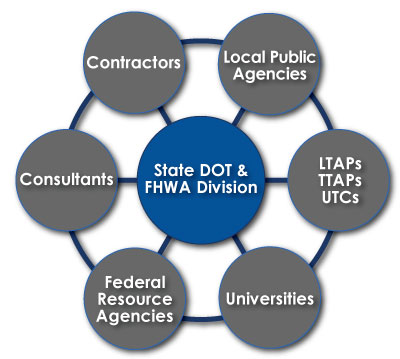
America's highway system faces a significant challenge: an aging infrastructure, growing traffic volumes and limited staffing and funding resources. Widespread use of innovation and enhanced business processes is essential to meeting customer needs and increasing the efficiency of project delivery. Initiatives such as Every Day Counts (EDC), the second Strategic Highway Research Program (SHRP2) Implementation Assistance Program, the American Association of State Highway and Transportation Officials (AASHTO) Innovation Initiative, and others are designed to promote innovations and support the highway community by putting them into practice. Whether through training, workshops, demonstrations, technical assistance or incentive funding, the result of these initiatives is rapid technology transfer and accelerated deployment of innovation across the nation.
Key components to the success of innovation deployment programs such as EDC are the state-based approach and the State Transportation Innovation Council (STIC) concept. A STIC or other equivalent task force, committee or group is intended to bring together public and private transportation stakeholders to evaluate innovations and spearhead their deployment in each State. The STIC or an equivalent group puts the highway community in each State in the driver’s seat to comprehensively and strategically consider sources of innovation, select those innovations that best fit its unique program needs, and then quickly put those innovations into practice. A formalized council or group affirms a State’s commitment to institutionalize innovations, ensuring innovation deployment will continue as a business practice for years to come—establishing a culture of innovation.
Each State operates its innovation deployment council, task force, committee or group based on its unique business needs and approaches to meeting those needs. For example, a state may have an established highway research board to provide guidance on using funds to research topics related to secondary roads. The board could be enhanced to include a broad range of representatives from the DOT as well as city and county agencies, industry association representatives, and FHWA thus making it a suitable organization to serve as the innovation deployment council or similar group.
States with a strong culture of innovation are able to leverage the resources of the highway community within the State and get the appropriate innovations into practice quickly. The establishment of a well-organized STIC or equivalent group, defined processes and procedures, and engaged leadership serve as the foundation for fostering a culture of innovation within a State. FHWA's State Transportation Innovation Council (STIC) Incentive Program and the Demonstration Project Program will help States institutionalize innovations and meet their innovation deployment goals.
Every state and territory now has an innovation deployment council completing a national STIC network. Building the STIC network is just the beginning. Now it is time to put it to work.

